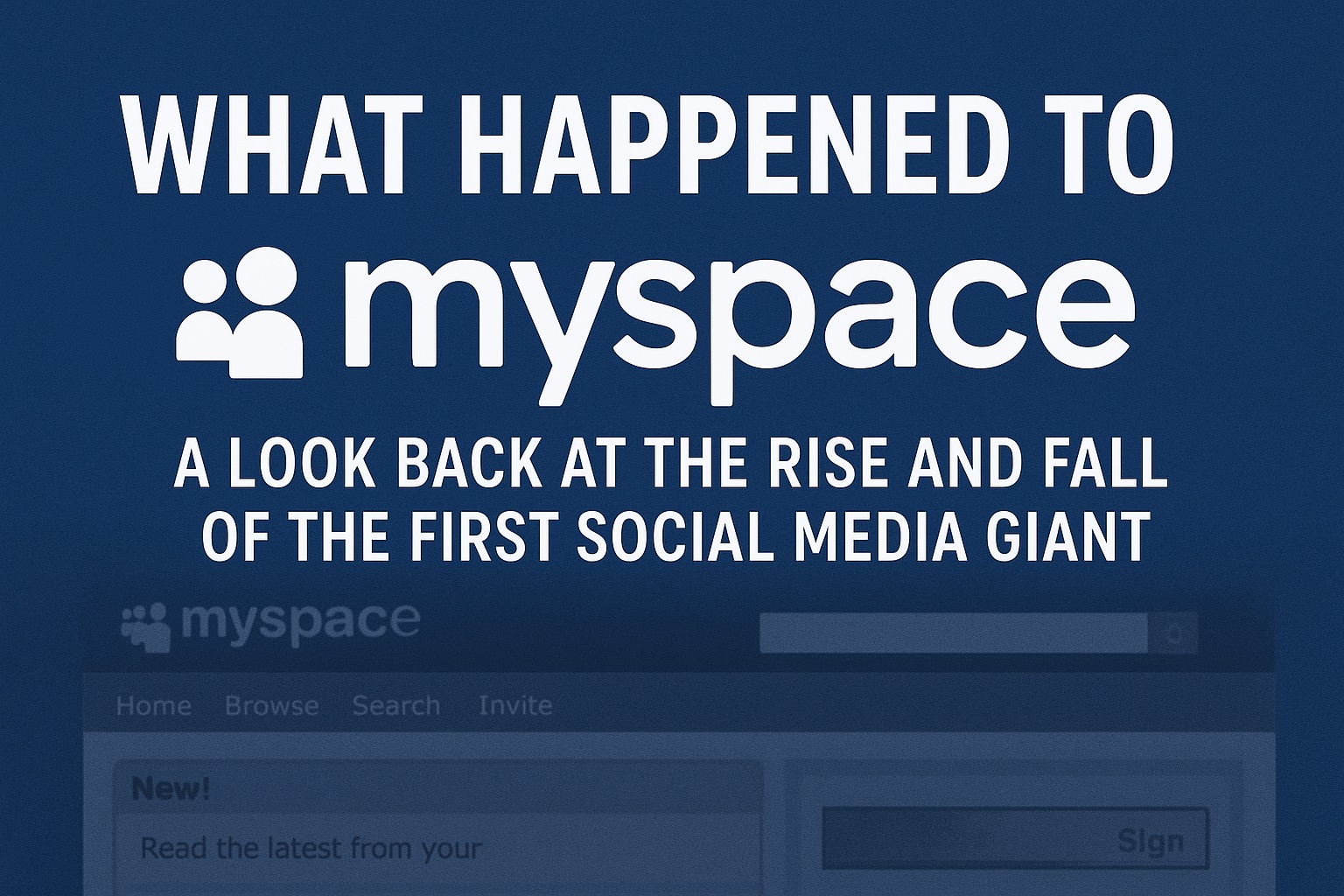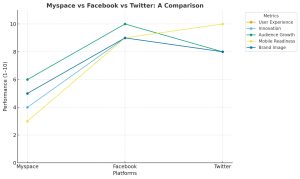
If you were online in the early 2000s, chances are you had a Myspace page. At its peak, Myspace was the place to be. People used it to share music, post blogs, customize personal profiles, and connect with friends. For many, it was their first taste of social networking. But today, people often ask: what happened to Myspace? Is Myspace still active? Does Myspace still exist?
The story of Myspace is fascinating. It went from being the number one social media platform in the world to a site that most people now barely remember. Let’s explore when Myspace started, when Myspace ended, why Myspace failed, and what Myspace is used for now.
Before Facebook, Instagram, and TikTok dominated our screens, there was Myspace. But what is Myspace exactly?
Launched in 2003, Myspace was one of the first major social networking platforms. It allowed users to create a Myspace page, upload photos, write blog posts, and most famously, customize their profiles with music, backgrounds, and flashy designs. For many teenagers, having a cool Myspace profile was a badge of honor.
When did Myspace come out? The official Myspace release date was August 2003. The platform quickly caught fire and by 2005, it was the most visited website in the United States—even surpassing Google for a short time.
So, when did Myspace start being popular? Almost immediately after launch. By 2005, Myspace had millions of users. By 2008, it had more than 100 million.
Why was Myspace so popular?
Customization: Everyone’s Myspace page looked different.
Music: Bands could upload their tracks, and fans could discover new artists.
Community: It felt like a digital hangout spot.
Artists like Arctic Monkeys, Adele, and even Drake gained attention thanks to Myspace. In fact, some music historians credit the platform for revolutionizing the music industry.
So, when was Myspace popular? The golden years of Myspace were between 2005 and 2008. During this period, the platform had millions of active users, especially teens and young adults. In fact, many people still ask: how many people used Myspace?
At its peak, Myspace had over 100 million users worldwide, and it became the go-to social media hub for music, pop culture, and personal expression. It was also the platform where artists like Arctic Monkeys and Lily Allen got their big breaks.
But things began to change quickly.
So, whatever happened to Myspace? Why did Myspace die? Why was Myspace shut down—or at least, why did it fall off?
Several factors contributed to the Myspace downfall:
Competition from Facebook – When Facebook opened to the public in 2006, users began migrating to its cleaner design and easier interface. Unlike Myspace, Facebook didn’t allow overwhelming customizations that slowed down page load times.
Poor Management Decisions – Myspace was purchased by News Corporation in 2005 for $580 million. Instead of focusing on improving user experience, the platform shifted towards advertising and clutter.
Security and Privacy Issues – Many users complained that Myspace was prone to spam, fake profiles, and weak privacy protections.
Slow Innovation – While Facebook was rolling out features like the news feed and mobile integration, Myspace struggled to adapt.
By the late 2000s, Myspace active users started to drop sharply. People moved on, and the once-iconic site became a relic.
A common question is: when did Myspace shut down? The truth is, Myspace never officially shut down.
So, does Myspace still exist? Yes, Myspace still works, though it looks very different today. But for many, when did Myspace die? The “death” of Myspace in a cultural sense came around 2009–2011, when Facebook took over as the dominant social media site.
If you’re wondering when did Myspace start and end, here’s a timeline:
Myspace creation date: 2003
Peak popularity: 2005–2008
Decline began: 2009
Major redesigns: 2013 onwards
Myspace today: Still active, mainly as a music and entertainment platform
Yes, you can. Does Myspace still work? It does. The site has gone through multiple redesigns and is now focused on music, entertainment, and pop culture.
So, what is Myspace now? Instead of being a broad social networking site, it rebranded as a place for artists, bands, and fans to share music and videos.
But do people still use Myspace in 2025? The answer is: very few. Myspace active users today are mainly musicians, nostalgic fans, or people curious to see what’s left of the platform.
When did Myspace stop? The platform lost its majority audience around 2010. By then, Facebook had taken the lead, and Myspace traffic had fallen by nearly half.
So, when did people stop using Myspace? Most users abandoned it between 2009 and 2012. This period is often referred to as the time when Myspace fell off.
If you’re asking, why did Myspace shut down or why did Myspace end, the answer is that it failed to keep up with its competitors.
User Experience Issues: Myspace pages were often cluttered with flashing GIFs, music that auto-played, and slow load times.
Lack of Innovation: While Facebook kept introducing new features, Myspace lagged.
Focus on Ads: Instead of improving functionality, it focused heavily on monetization.
In short, Myspace failed because it didn’t evolve fast enough.
So, in 2025–2026, is Myspace still a thing? Technically, yes.
You can still visit the Myspace website and create an account. The platform is mostly about music, videos, and entertainment news. While it doesn’t compete with giants like Facebook, YouTube, or TikTok, it serves as a niche site.
So, what is Myspace used for now? Think of it as a hybrid between a music streaming site and an entertainment blog.
You might be wondering: who owns Myspace now? After changing hands multiple times, Myspace is currently owned by Viant Technology, which is itself owned by Meredith Corporation.
This shows that although Myspace is “dead” in terms of popularity, it’s not completely gone.
Another common question is: was Myspace the first social media platform? Not exactly. Before Myspace, there were sites like Friendster and LiveJournal. But Myspace was the first to bring social networking into the mainstream.
It paved the way for modern platforms like Facebook, Twitter, Instagram, and TikTok.
What did Myspace look like? Myspace allowed full customization, so no two pages looked the same. Some were simple, while others had flashing text, glitter backgrounds, and embedded music players.
How long did Myspace last? Culturally, about 6–8 years. Technically, it’s still around.
How much is Myspace worth today? A fraction of its original value—far less than the billions once speculated.
Does anyone still use Myspace? Yes, but mainly musicians and nostalgic users.
To understand what happened to Myspace, it helps to compare it with the two platforms that replaced it: Facebook and Twitter (now X).
Myspace: Allowed extreme customization. Users could add music, backgrounds, and flashy effects, but this often made pages slow and messy.
Facebook: Offered a clean, uniform design that made navigation simple and fast.
Twitter: Focused on quick, bite-sized posts (tweets), making it lightweight and addictive.
👉 Lesson: While people loved creativity, they preferred speed and simplicity.
Myspace: Slow to roll out new features. It didn’t adapt well to the smartphone era.
Facebook: Constantly updated—introduced the News Feed, photos, groups, and eventually apps.
Twitter: Created an entirely new way of communicating with real-time updates and hashtags.
👉 Lesson: Platforms that evolve quickly survive longer.
Myspace: Started strong with teens and music fans, but struggled to attract professionals and older users.
Facebook: Started with college students, then expanded to everyone—teens, adults, and businesses.
Twitter: Attracted celebrities, journalists, and politicians, making it influential in global conversations.
👉 Lesson: Platforms that appeal to diverse groups scale faster.
Myspace: Designed for desktop, and never fully transitioned to mobile.
Facebook: Quickly embraced mobile apps, which became its biggest strength.
Twitter: Thrived on mobile-first usage, perfect for quick posts on the go.
👉 Lesson: Missing the mobile shift was a huge factor in why Myspace failed.
Myspace: Became associated with clutter, spam, and “old internet” vibes.
Facebook: Marketed itself as professional and modern.
Twitter: Positioned itself as the go-to place for instant news and global conversations.
👉 Lesson: Branding matters—Myspace never shook off its “teen site” image.
In short:
Myspace fell off because it couldn’t keep pace with changing user needs.
Facebook thrived because it offered a clean design, frequent innovation, and broader appeal.
Twitter found its niche by being the fastest way to share thoughts and news.
That’s why today, when people ask is Myspace still a thing, the answer is yes—but only as a music site, while Facebook and Twitter remain household names.

So, is Myspace dead? Not completely. While Myspace is no longer popular, and many people assume it shut down, the truth is that it still exists—just in a very different form.
If you’re wondering what happened to Myspace, the simple answer is this: it failed to adapt to changing user needs, was overtaken by Facebook, and lost its audience. Today, Myspace survives as a niche entertainment platform, but it will never reclaim the cultural dominance it once had.
For those who were around during its heyday, Myspace will always be remembered as the platform that started it all—the first real taste of what social media could be.
